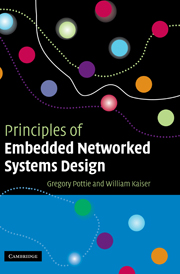Book contents
- Frontmatter
- Contents
- Preface
- Acknowledgments
- List of Abbreviations
- 1 Embedded network systems
- 2 Representation of signals
- 3 Signal propagation
- 4 Sensor principles
- 5 Source detection and identification
- 6 Digital communications
- 7 Multiple source estimation and multiple access communications
- 8 Networking
- 9 Network position and synchronization services
- 10 Energy management
- 11 Data management
- 12 Articulation, mobility, and infrastructure
- 13 Node architecture
- 14 Network data integrity
- 15 Experimental systems design
- 16 Ethical, legal, and social implications of ENS
- 17 Design principles for ENS
- Appendix A Gaussian Q function
- Appendix B Optimization
- Index
17 - Design principles for ENS
Published online by Cambridge University Press: 10 August 2009
- Frontmatter
- Contents
- Preface
- Acknowledgments
- List of Abbreviations
- 1 Embedded network systems
- 2 Representation of signals
- 3 Signal propagation
- 4 Sensor principles
- 5 Source detection and identification
- 6 Digital communications
- 7 Multiple source estimation and multiple access communications
- 8 Networking
- 9 Network position and synchronization services
- 10 Energy management
- 11 Data management
- 12 Articulation, mobility, and infrastructure
- 13 Node architecture
- 14 Network data integrity
- 15 Experimental systems design
- 16 Ethical, legal, and social implications of ENS
- 17 Design principles for ENS
- Appendix A Gaussian Q function
- Appendix B Optimization
- Index
Summary
This brief chapter summarizes a number of the design themes that are threaded through the book, expanding upon the design heuristics introduced in Chapter 1. The section headings denote the basic principles.
The physical world may not be abstracted away
While philosophers have doubted the existence of an objective reality, engineers will not get very far in the development of embedded systems without at least modeling the physical world as such. The purpose of an embedded system is to gather some information about the physical world and then take some action, if only to report that information to some other entity. As such an understanding of the physical process being monitored or controlled is essential. Chapter 2 provided some of the mathematical tools used in modeling such processes, while Chapter 3 discussed some of the basic propagation laws for natural and man-made signals.
There are fundamental limits to how well it is possible to observe phenomena with a given set of sensors, due to the presence of noise, obstructions, and propagation losses. There are similarly fundamental limits on communications capacity, while for any real apparatus computational, storage, and energy resources are also limited. System design must respect these limits and explore how resources can best be added to meet performance requirements while living within cost constraints. There are occasions when questions such as “what would happen if resource x were free?” are appropriate (e.g., in imagining some limiting case as a useful approximation) and others where they are not (e.g. when it comes to implementing the practical system).
- Type
- Chapter
- Information
- Principles of Embedded Networked Systems Design , pp. 494 - 498Publisher: Cambridge University PressPrint publication year: 2005



